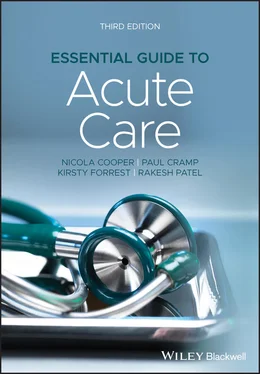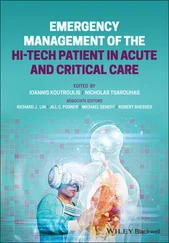Integral to the management of the acutely ill patient is the administration of effective analgesia. This is extremely important to the patient but also has a range of physiological benefits and is discussed further in Chapter 10.
Special Considerations in the Geriatric Population
The proportion of older people in the population is increasing. Around 80% of people aged over 80 years function well and relatively independently and only 13.7% of people aged over 85 years live in institutions in the UK. 20However, there are important physiological differences in this age group which are important for healthcare staff to understand. The interpretation of symptoms and signs and the management of acute illnesses may be different in the elderly population.
The following are important physiological differences in older people:
Reduced homeostatic reserve: ageing is associated with a decline in organ function with a reduced ability to compensate. The following are reduced – normal PaO2, cerebral blood flow, maximum heart rate and cardiac reserve, maximum oxygen consumption, renal blood flow, maximum urinary concentration, and sodium and water homeostasis
Impaired immunity: older patients commonly do not have a fever or raised white cell count in infection. Hypothermia may occur instead. A rigid abdomen is uncommon in the older people with an acute abdomen – they are likely to have a soft, but generally tender abdomen despite perforation, ischaemia, or peritonitis. A lower threshold for imaging is therefore required
Different pharmacokinetics and pharmacodynamics: a different approach to anaesthesia is required, and iatrogenic disease is more common in the older population
Acute illnesses present atypically e.g. with delirium or falls
Quiescent diseases are exacerbated by acute illness e.g. heart failure may occur due to pneumonia, old neurological signs may become more pronounced with an acute infection
Some clinical findings are not necessarily pathological in older people: neck stiffness, fine crackles at the lung bases, reduced skin turgor, and bacteriuria. A urinary tract infection cannot be diagnosed on the basis of urinalysis alone.
Clinical decision‐making should always be made on an individual basis and never on the basis of age alone. However, one has to balance the right to high‐quality care without age discrimination with the wisdom to avoid aggressive but ultimately futile interventions. Involving an experienced physician in difficult decision‐making is often helpful.
The Benefits and Limitations of Intensive Care
Physiological derangement and the need for admission to the ICU is not the same thing. It would not be in the best interests of all patients to be admitted to an ICU. Instead, optimising ward care or even palliative care may be required. 21This decision is based on evidence about prognosis, clinical experience (e.g. recognising when someone is dying), and takes in to account any expressed wishes of the patient. Intensive (level 3) care supports failing organ systems when there is potentially reversible disease. It is appropriate for patients requiring advanced respiratory support alone or support of at least two failing organ systems. High dependency (level 2) care is appropriate for patients who require detailed observation or intervention for a single failing organ system.
For the majority of healthcare workers who have never worked in an ICU, the benefits and limitations of what is available may be poorly understood. Patients with acute reversible disease benefit most from intensive care if they are admitted sooner rather than later. Waiting for someone to become even more seriously ill before contacting the ICU team does not make physiological sense and is not evidence‐based. On the other hand, admission to the ICU does not guarantee a successful outcome. Some patients may be so ill they are unlikely to recover at all, even with intensive organ support. The overall mortality of patients admitted as an emergency to the ICU in the UK is around 25%, but this varies between units and different patient populations. 14,22All potential admissions should be assessed by an experienced doctor. Patients who are not admitted to intensive care should have a clear plan and their ward care optimised.
Communication and the Critically Ill
In recent years, healthcare has increasingly focussed on systems and processes that improve patient safety. One important facet of patient safety is ‘human factors’ – how people interact with each other and technology. Good communication, teamwork, and situation awareness can be as important in successfully managing an acutely ill patient as having good medical knowledge and skills.
A new doctor once asked his senior how to treat a patient who had had too much β‐blocker. The senior was half listening, writing in some notes. Another senior was nearby and asked, ‘What do you mean – what is the pulse and blood pressure?’ The new doctor replied, ‘Pulse 30, blood pressure unrecordable’. Both seniors dashed to the patient’s bedside. Good communication is important. SBARR is a simple system to follow when communicating about a seriously ill patient with colleagues, particularly over the phone. It is illustrated in Box 1.4.
Clearly communicating the patient’s current vital signs and key test results is the only way to give the listener a sense of how urgent the situation is. Your colleague may have heard all he needs to know and be on his way, or he may want to go through some more details first. Either way, it is important to communicate clearly what help is required, particularly if you want your colleague to come and see the patient. The senior resident doctor should always be informed about any seriously ill patient, whether or not his expertise is required.
The following chapters describe the theory behind the assessment and management of acutely ill adults. They are intended as a foundation on which experience and practical training can be built. Understanding and practising the basics well is the essence of good acute care. Good acute care can even be summed up as ‘the right oxygen, the right fluid and the right help at the right time’. Hopefully by the end of this book, you will have a better idea of what this means and have a better understanding of the significance of common clinical findings. These simple things can make a big difference to your patients.
Box 1.4The SBARR System of Communication
Situation State who you are, where you are, and why you are calling
Background Summarise the patient’s relevant history
Assessment Communicate the patient’s vital signs and key test results
Recommendation State clearly what you want to happen next
Readback The listener should summarise what they think you have said and what they are going to do now
Example:
Hi – I am Dr X calling from Ward 1 about a sick patient I think may need ICU. Joe Bloggs, 45 years old, no past medical history, was admitted with community acquired pneumonia this morning with a NEWS2 of 3. Over the course of the day, his oxygen requirements have been going up and his blood pressure is now low despite fluid challenges.His current vital signs are: Alert, BP 90/50, HR 110, SpO2 89% on 15 L oxygen via reservoir bag, RR 26, temperature 38°C. A repeat chest X‐ray shows worsening consolidation of the right lung and a repeat blood gas shows … I’d be really grateful if you can come and assess him urgently.
Key Points – Patients at Risk
Resuscitation is about recognising and effectively intervening when patients have seriously abnormal vital signs
There is a wealth of research to show that our systems fail when patients in hospital deteriorate
Читать дальше












